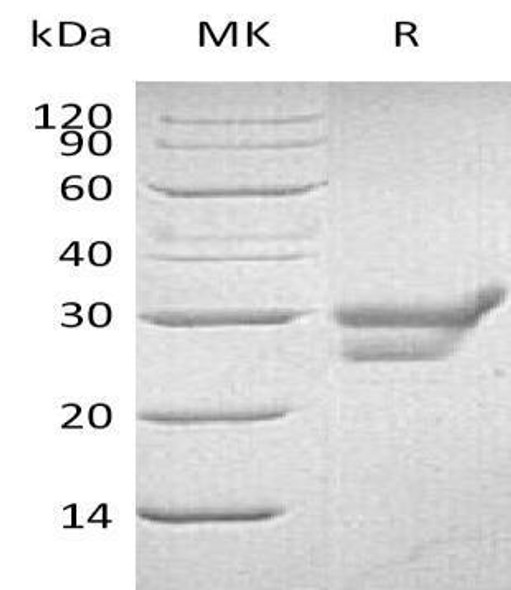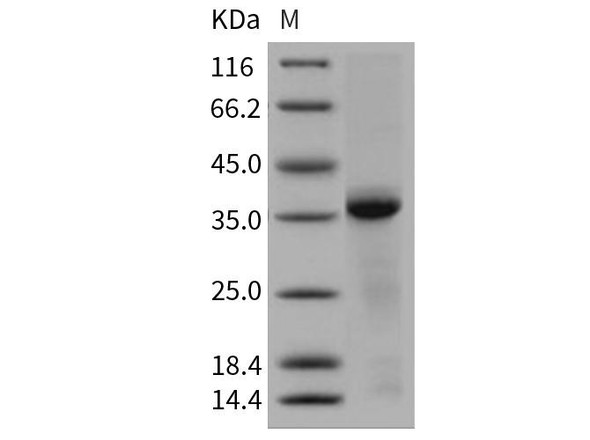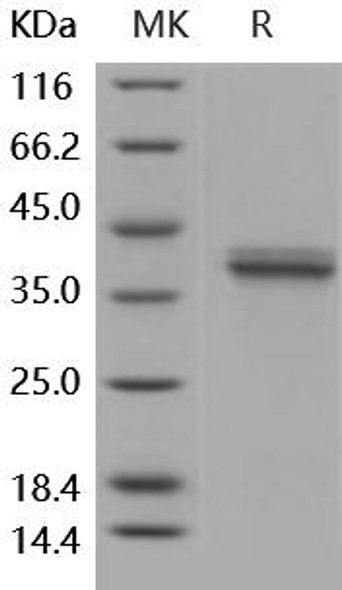Description
| Product Name: | Human CTSL Recombinant Protein |
| Product Code: | RPPB1519 |
| Size: | 20µg |
| Species: | Human |
| Target: | CTSL |
| Synonyms: | Cathepsin L, CTSL1, Cathepsin L1, Major Excreted Protein,MEP, EC 3.4.22.15, CATL, EC 3.4.22. |
| Source: | Escherichia Coli |
| Physical Appearance: | Sterile Filtered clear solution. |
| Formulation: | CTSL protein solution (1mg/ml) containing 20mM Tris-HCl (pH 8.0) and�10% glycerol. |
| Stability: | Store at 4°C if entire vial will be used within 2-4 weeks. Store, frozen at -20°C for longer periods of time.For long term storage it is recommended to add a carrier protein (0.1% HSA or BSA).Please avoid freeze thaw cycles. |
| Purity: | Greaterthan 90% as determined by SDS-PAGE. |
| Amino Acid Sequence: | MGSSHHHHHH SSGLVPRGSH MGSTLTFDHS LEAQWTKWKA MHNRLYGMNE EGWRRAVWEK NMKMIELHNQ EYREGKHSFT MAMNAFGDMT SEEFRQVMNG FQNRKPRKGK VFQEPLFYEA PRSVDWREKG YVTPVKNQGQ CGSCWAFSAT GALEGQMFRK TGRLISLSEQ NLVDCSGPQG NEGCNGGLMD YAFQYVQDNG GLDSEESYPY EATEESCKYN PKYSVANDTG FVDIPKQEKA LMKAVATVGP ISVAIDAGHE SFLFYKEGIY FEPDCSSEDM DHGVLVVGYG FESTESDNNK YWLVKNSWGE EWGMGGYVKM AKDRRNHCGI ASAASYPTV |
Cathepsin-L also known as CTSL is a member of the peptidase C1 family.CTSL, is a dimer composed of disulfide-linked heavy and light chains, bothformed from a single protein precursor. Furthermore, CTSL is a lysosomalcysteine proteinase which takes a main part in intracellular proteincatabolism. CTSL substrates include collagen and elastin, as well as alpha-1protease inhibitor, which is the most important controlling element ofneutrophil elastase activity. CTSL has been implicated in a number of pathologicprocesses, including myofibril necrosis in myopathies and in myocardialischemia, and in the renal tubular response to proteinuria. Multiplealternatively spliced transcript variants have been found for CTSL.
CTSL Human Recombinant produced in E.Coli is a single,non-glycosylated polypeptide chain containing 339 amino acids (18-333 a.a) andhaving a molecular mass of 38.3kDa.CTSL is fused to a 23 amino acid His-tag at N-terminus& purified by proprietary chromatographic techniques.
| UniProt Protein Function: | Important for the overall degradation of proteins in lysosomes. |
| NCBI Summary: | The protein encoded by this gene is a lysosomal cysteine proteinase that plays a major role in intracellular protein catabolism. Its substrates include collagen and elastin, as well as alpha-1 protease inhibitor, a major controlling element of neutrophil elastase activity. The encoded protein has been implicated in several pathologic processes, including myofibril necrosis in myopathies and in myocardial ischemia, and in the renal tubular response to proteinuria. This protein, which is a member of the peptidase C1 family, is a dimer composed of disulfide-linked heavy and light chains, both produced from a single protein precursor. Multiple alternatively spliced transcript variants have been found for this gene. [provided by RefSeq, Apr 2012] |
| UniProt Code: | P07711 |
| NCBI GenInfo Identifier: | 115741 |
| NCBI Gene ID: | 1514 |
| NCBI Accession: | P07711.2 |
| UniProt Secondary Accession: | P07711,Q6IAV1, Q96QJ0, |
| UniProt Related Accession: | P07711 |
| Molecular Weight: | 38kDa |
| NCBI Full Name: | Cathepsin L1 |
| NCBI Synonym Full Names: | cathepsin L |
| NCBI Official Symbol: | CTSL�� |
| NCBI Official Synonym Symbols: | MEP; CATL; CTSL1�� |
| NCBI Protein Information: | cathepsin L1 |
| UniProt Protein Name: | Cathepsin L1 |
| UniProt Synonym Protein Names: | Cathepsin L; Major excreted protein; MEP |
| UniProt Gene Name: | CTSL�� |









